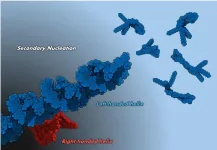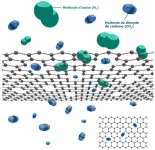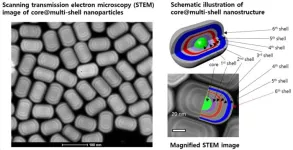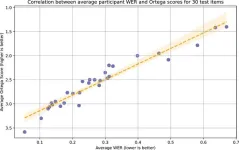(Press-News.org)
Self-assembly or self-organization in molecular science refers to the phenomena where molecules spontaneously gather and form ordered structures, a unique property of materials used to develop optical and electronic materials. In a step towards fine-tuning this property, researchers from Japan successfully elucidated a technique where a small amount of residual aggregates drastically altered the self-assembly process of photo-responsive molecules. The research team was led by Professor Shiki Yagai from the Graduate School of Engineering, Chiba University, including Assistant Professor Takuho Saito from Nagoya University (at the time of research), Mr. Daisuke Inuoe, and Assistant Professor Yuichi Kitamoto from Tohoku University, as major contributors of this work. The findings of their study were published online in Nature Nanotechnology on April 11, 2025.
In recent years, there has been an increasing focus in research on controlling the size and hierarchical structures of self-assembled aggregates, which could help achieve aggregates with desired properties. However, self-assembly is a dynamic process and requires precise control. “During the process of self-assembly, the molecules repeatedly continue to associate and dissociate,” explains Prof. Yagai, “Even minute impurities or slight changes in the conditions can impact the final structure of the formed aggregates.”
For the study, the research team focused on the self-assembly of a chiral, photoresponsive azobenzene that naturally forms left-handed helical aggregates. The team discovered that the presence of a small amount of residual aggregates within the solution induces a drastic change in the assembly process and leads to the formation of right-handed helical aggregates instead. Moreover, being photoresponsive, controlling the exposure to light also modifies the timing of molecular assembly. Using precise control of these two properties together, the researchers successfully manipulated the formation of either left-handed or right-handed helical aggregates as required.
In spectroscopic and molecular modeling studies, the team found that when the scissor-shaped azobenzene molecule is dissolved in an organic solvent at room temperature, it forms a closed scissor-like folded structure that further extends into a helical assembly. Prof. Yagai explains the formation of left-handed assembly, saying, “The molecule contains a carbon atom that has four different atomic groups and therefore exhibits chirality. These molecules fold like left-handed scissors and twist to form a left-handed helical stacking of the assembly.”
Since these are photoresponsive molecules, when the stacked helical structures are exposed to weak ultraviolet (UV) light, the helical assembly disassembles back into individual molecules, and upon subsequent exposure to visible light, the molecules reassemble into helical structures again. Interestingly, under certain conditions, the resulting helical aggregates were found to be right-handed instead of left-handed, and exposure to stronger UV light followed by visible light led to the regeneration of the original left-handed helical aggregates.
By closely investigating this mechanism, the team found that when solutions were exposed to weak UV light, there was a minute amount of residual left-handed helical aggregates that remained unchanged, and these aggregates acted as nucleation sites forming oppositely directed helical assemblies. “This remarkable phenomenon is called ‘secondary nucleation,’ which explains why meta-stable right-handed aggregates are preferably formed instead of left-handed aggregates,” says Prof. Yagai.
In addition to this, the team also discovered the role of light intensity in the molecular assembly process. Prof. Yagai explains, “We identified that the intensity of visible light potentially affected the timing of the assembly. Strong visible light promoted rapid assembly while minimizing the influence of the residual aggregates. In contrast, weaker intensity magnifies the effect of the residual aggregates.”
Therefore, by optimizing the intensities of UV and visible light, the researchers successfully controlled the switching between left- and right-handed helical structures which were dependent on the influence of the residual aggregates. Moreover, it was also found that the stable left-handed aggregates and meta-stable right-handed aggregates also exhibit opposite electron spin polarization, which signifies the tuning of electronic characteristics of the helices.
Overall, this study aimed to explore the critical role of residual aggregates and explained how light-enabled fine-tuning can result in the fabrication of novel functional materials, giving promising insights into the field of material science.
About Professor Shiki Yagai from Chiba University
Professor Shiki Yagai is a well-established researcher at Chiba University, Japan. He currently serves as a professor at the Graduate School of Engineering, Chiba University, Japan. He has authored over 200 publications, contributing to the fields of molecular self-assembly, supramolecular polymers, and functional dyes with a focus on their nanostructural control. Prof. Yagai leads the Grant-in-Aid for Transformative Research Areas (A) project titled "Materials Science of Meso-Hierarchy" which spans from 2023 to 2027. This project focuses on exploring the hierarchical structures of materials to develop innovative functional materials at the mesoscopic scale. The initiative aims to deepen the understanding of meso-hierarchical structures and their impact on material properties, potentially leading to breakthroughs in material design and applications.
See more in https://mesohierarchy.jp/en/
END
CAMBRIDGE, MA -- Bacteria can be engineered to sense a variety of molecules, such as pollutants or soil nutrients. In most cases, however, these signals can only be detected by looking at the cells under a microscope or similarly sensitive lab equipment, making them impractical for large-scale use.
Using a new method that triggers cells to produce molecules that generate unique combinations of color, MIT engineers have shown that they can read out these bacterial signals from as far as 90 meters away. Their work could lead to the development of bacterial sensors for agricultural and other applications, which could be monitored by drones or ...
Capturing carbon dioxide (CO₂) from industrial emissions is crucial in the fight against climate change. But current methods, like chemical absorption, are expensive and energy-intensive. Scientists have long eyed graphene—an atom-thin, ultra-strong material—as a promising alternative for gas separation, but making large-area, efficient graphene membranes has been a challenge.
Now, a team at EPFL, led by Professor Kumar Agrawal, has developed a scalable technique to create porous graphene membranes ...
Researchers have developed a simple and cost-effective blood test capable of detecting Parkinson’s disease long before symptoms emerge, comparing the current state of diagnosing neurodegenerative diseases to the fight against cancer 50 years ago—when most cases were identified too late for effective treatment. The test quantifies specific RNA fragments in the blood, focusing on a repetitive RNA sequence that accumulates in Parkinson’s patients and a parallel decline in mitochondrial RNA, which deteriorates as the disease progresses. By measuring the ratio between these biomarkers, the test offers a highly accurate, non-invasive, rapid and affordable diagnostic tool, ...
A novel paper led by Dr Ulrich Brose of the German Centre for Integrative Biodiversity Research (iDiv) and the Friedrich Schiller University Jena is widening understanding of how species interact within ecosystems via the so-called “Internet of Nature.” Published in Nature Ecology and Evolution, the paper reveals that species not only exchange matter and energy but also share vital information that influences behaviour, interactions, and ecosystem dynamics – revealing previously hidden characteristics of natural ecosystems.
Traditionally, ecological studies have ...
Police officers are more than twice as likely to have traumatic brain injuries compared to the general population. Officers who incur these injuries while on duty face more than double the risk of developing complex post-traumatic stress disorder (PTSD).
That’s according to a new survey-based study from the University of Exeter, published in The Journal of Head Trauma Rehabilitation, which found a connection between traumatic brain injuries and PTSD in police officers. Authors say the findings ...
SINGAPORE, 11 APRIL 2025—Duke-NUS Medical School has appointed Professor Patrick Tan as its next and fourth Dean, effective 1 January 2026, marking a new chapter for the School as it builds on its legacy of medical education, research and innovation. Prof Tan will serve as Dean-designate from 1 July 2025, succeeding Professor Thomas Coffman, the School’s longest-serving Dean since 2015. This leadership transition coincides with the School’s 20th anniversary, underscoring Duke-NUS’ commitment to advancing ...
Since cefixime and tellurite are known to inhibit most bacteria belonging to Enterobacterales, we found that addition of tellurite inhibited E. albertii growth in Luria Bertani broth but not in tryptic soy broth (TSB), and addition of phosphate and soy peptone enhanced E. albertii growth in TSB in presence of tellurite.
Subsequently, to find the positive factor present in TSB, E. albertii growth was examined in tryptone, soy peptone, glucose, or phosphate deficient tryptic soy agar plates. Phosphate, soy peptone, and/or ...
Dr. Ho Seong Jang and colleagues at the Extreme Materials Research Center at the Korea Institute of Science and Technology (KIST) have developed an upconversion nanoparticle technology that introduces a core@multi-shell nanostructure, a multilayer structure in which multiple layers of shells surround a central core particle, and enables high color purity RGB light emission from a single nanoparticle by adjusting the infrared wavelength.
Luminescent materials are materials that light up on their own and are used in a variety of display devices, including TVs, tablets, monitors, and smartphones, to allow us to view a variety of images ...
In today’s increasingly interconnected world, language learning has become essential for education, business, and cultural exchange. However, accurately measuring proficiency in language learners is a complex matter. One particularly valuable approach involves asking learners to listen to sentences and then repeat them back as accurately as possible. Known as elicited imitation (EI), this method reveals much more than mere memory and mimicking abilities. When sentences exceed our working memory capacity—typically beyond 8 to 10 syllables—successful repetition requires learners to quickly process and ...
The persistent higher rate of alcohol deaths in England since the pandemic in 2020 is an “acute crisis” requiring urgent action from government, according to a new study led by researchers at UCL and the University of Sheffield.
For the study, published in Lancet Public Health, researchers analysed Office for National Statistics (ONS) figures of deaths caused solely by alcohol in England. They found that death rates were stable between 2009 and 2019, but increased by a fifth in 2020, rising by a further 13.5% between 2020 and 2022.
The team estimated that 3,911 more people had died solely because of alcohol in England ...




